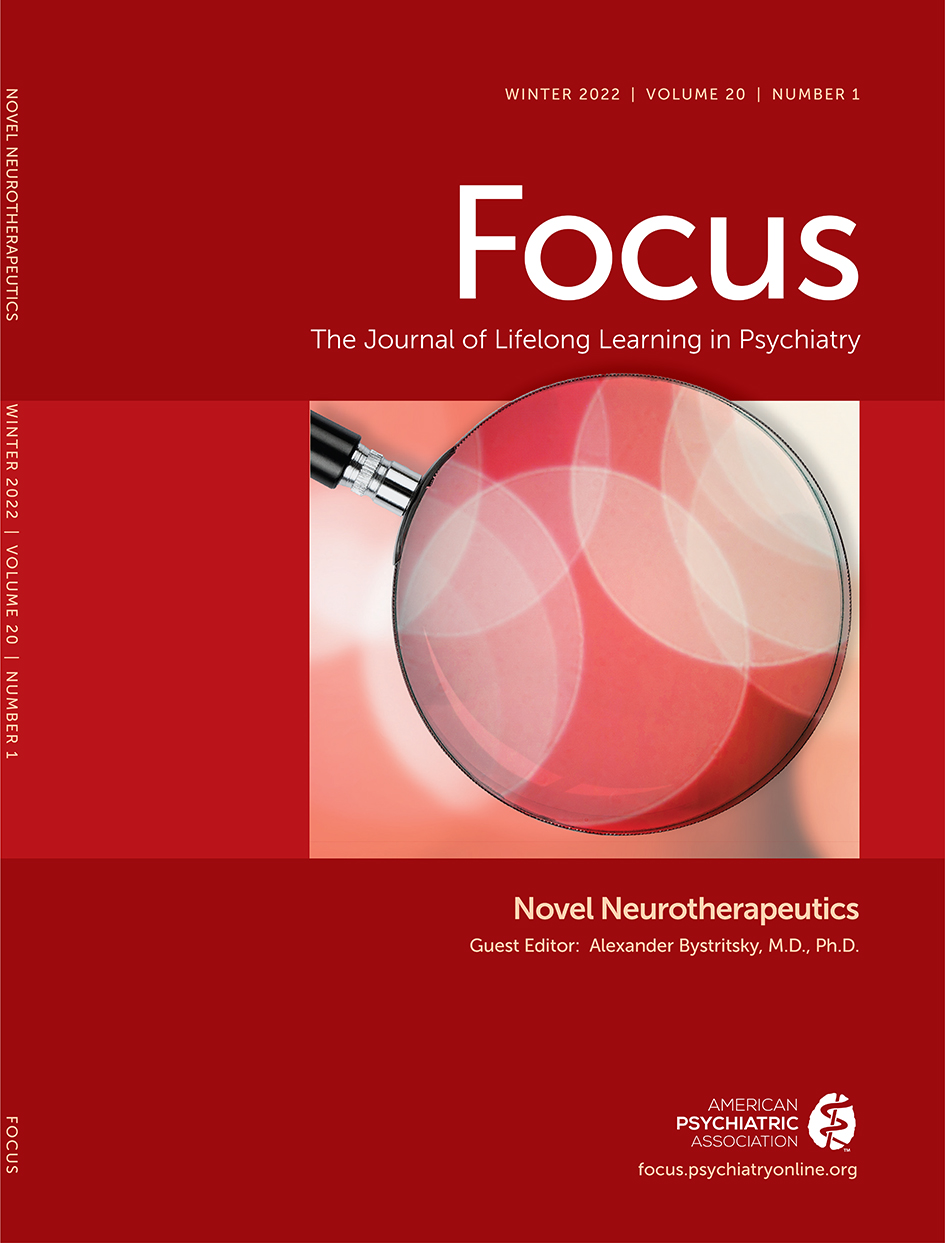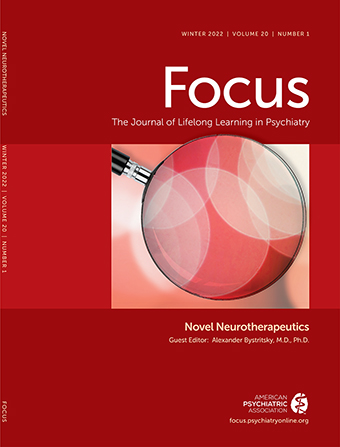Over the past several decades, many advancements have occurred in the field of clinical neuroscience, particularly in the ability of functional neuroimaging to relate psychopathology to corresponding brain areas. As the field has progressed, however, it has become more evident that simply mapping complex psychological syndromes onto individual brain areas is insufficient. Rather, the future of cognitive neuroscience may lie in the examination of specific symptom domains and modulation of corresponding brain areas in relation to their role in functional networks (
1).
Since its inception in 1990, functional magnetic resonance imaging (fMRI) has been used primarily to examine signals from brain regions that show blood oxygen level-dependent changes in response to a given cognitive task (
2). As a clinical tool, fMRI is frequently utilized in mapping of language and motor areas prior to resective surgery. However, focus has recently shifted toward examining how multiple brain areas can be functionally connected. The most crucial of these functionally connected brain areas have been termed “networks,” and a few of these networks have been determined to be of vital importance to proper neuropsychological functioning. The most commonly discussed networks are the default mode network (DMN), salience network (SN), and central executive network (CEN). These three specific networks have been previously termed the “triple network model,” because the dynamic interactions between them make up much of cognitive processing abilities (
3).
Currently marketed psychiatric therapies are effective, on average, in approximately half the patients who use them. The arbitrary clustering of various symptoms with different pathophysiological pathways into one illness may be one cause for this low response rate. The transition from one-size-fits-all therapy to targeted, circuit-based therapy may improve the benefit-risk ratio for patients by improving the mechanistic understanding of disease and matching the correct therapies to the right individuals (
4). It could also aid with mental illness differential diagnosis and reclassification of heterogeneous subgroups within the same disorder (e.g., depression syndrome into agitated versus apathetic versus anhedonic symptoms or the autism spectrum into Research Domain Criteria [RDoC] symptom-based domains). Many existing mental diseases may thus be regarded as misclassified rather than as heterogeneous in this sense (
5). This was the impetus for the National Institute of Mental Health’s RDoC Initiative: to parse syndromes into levels (genetic, systems) of specificity (genes, symptoms), allowing for more precise characterization of the underpinnings that lead to and constitute mental illness. For the purposes of this article, we address the system (neural network) and psychiatric symptom domains.
This understanding of networks and their specific dysfunctions opens the possibility of a new form of psychopathological treatment. In this review, we examine the current literature on the role of brain networks in relation to different psychopathological symptom domains and discuss the corresponding circuit-based therapies that have been or may be used to treat them.
Discussion and Conclusions
The DMN has received much attention in the past decade as a target to link intrinsic activity to cognition and to examine how intrinsic signal changes may be altered in dysfunction (i.e., traumatic brain injury, depression, anxiety, psychosis, and PTSD) (
83). The DMN seems to be active during states of daydreaming, “wakeful rest,” retrospective simulation (remembering the past), prospective simulation (imagining the future), social cognition (imagining what others are thinking), and self-relevant tasks (
84). Anatomically, the network is typically thought to consist of the medial prefrontal cortex, PCC, and inferior parietal lobule, as well as the lateral temporal poles (
85).
The CEN (also referred to as the “frontoparietal network”) has been shown to be anticorrelated with the DMN, because it appears to be most active during states of top-down cognitive control functions, such as decision making, attentional control, working memory, and cognitive flexibility (
86,
87). The areas that typically constitute the CEN are the dlPFC and the posterior parietal cortex. These two networks (CEN and DMN) may be easily identified by examining the profile of activation and inactivation generally observed during cognitive tasks—where the CEN typically displays increases in activation, the DMN typically shows declines (
88). However, recent studies have shown interest in uncovering the psychopathology that underlies the inability of the brain to properly transition between these two states of network activation; notably, this process of transition has been shown to be mediated by the SN (
89).
The SN (also referred to as the “ventral attention network”) is highly implicated with marking events in time and space with the appropriate relevance and, when properly functioning, assists the other brain networks in generating appropriate behavioral responses to salient stimuli. According to this concept, the insula facilitates bottom-up access to the brain’s attentional and working memory resources. This is largely because the network is composed of the anterior insula, as well as the ACC. Evidence from network analysis suggests that the core function of the insula is to mark salient events for additional processing and initiate the appropriate control signals (
90). This marking of salient events seems to be critical in the overall network model, because further studies have shown that the anterior insula mediates the dynamic activity of the DMN and ECN, allowing for flexible attention to internal or external events (
91,
92).
As the major networks have become more commonly identified, it is becoming clear that a critical part of individual psychopathological dysfunction may lie in the characterization of the SN and its functional and temporal connections with the DMN and CEN, as well as other to-be-defined networks underlying specific neuropsychiatric symptoms. The majority of significant psychopathologies are being shown to entail failure of multiple complex networks that integrate several cognitive and emotion-regulating systems that rely on many lobes and scattered brain regions. Furthermore, the ability of the brain to rapidly switch between these networks has been shown to be a major discriminatory factor in healthy cognitive function. In a Human Connectome Project study examining the fMRI connectivity in 1,003 healthy adults, data showed that network switching speed was predictive of intersubject variation in working memory, planning, reasoning, and amount of sleep (
93). Furthermore, in a recent review, Bystritsky and colleagues (
48) looked at neurocircuitry underlying the multiple facets of anxiety and its presentations. More work along these lines using large metanalytic fMRI is needed to better separate the networks that underlie psychiatric illness.
In addition, many psychiatric diseases have symptom domains that may overlap with other disorders. For example, individuals with PTSD have severe anxiety, much like patients with OCD or GAD have anxiety. This makes it difficult to tease apart what is the primary dysfunctional network that leads to irregularity and maladaptive function in secondary networks. Future studies may look at these comorbid network dysfunctions to find what is common among persons presenting with a specific symptom domain.
By beginning to approach psychopathology in this fashion, the developing technologies of multimodal MRI and functional connectivity can be utilized to their fullest extent. To treat patients in a more effective, individualized manner, therapies must be further parsed to specific presenting symptoms. Currently, diagnosis and treatment at the syndrome level leave many patients suffering and symptomatic. Considering this, as well as the research into symptom domains that has been done by groups such as the RDoC, it is clear that the future of neuropsychological/psychiatric treatment lies in discovery of and research into respective networks and symptom presentations. If these aberrant networks can be further identified and treated (as suggested by the research presented in this review), a new era of noninvasive, precision, personalized, and MRI-based treatment may be possible.

